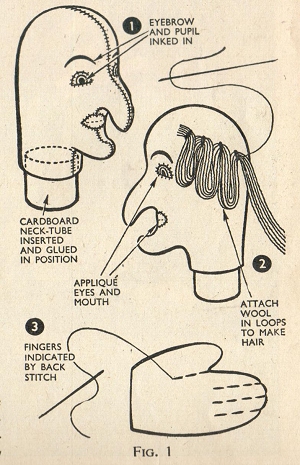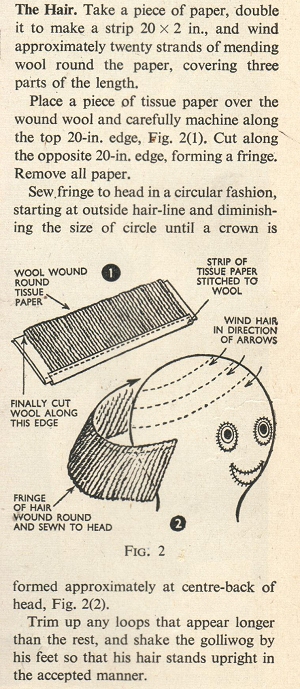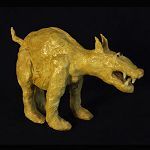Missmonster at Instructables details how she made her fabulous, scary and very furry werewolf costume. This photo is pre-fur!
(via Puppetbuilding.com)
Missmonster at Instructables details how she made her fabulous, scary and very furry werewolf costume. This photo is pre-fur!
(via Puppetbuilding.com)
I loved making these two little horses recently for an up-coming theatre production, Emma’s Dynasty, by Jigsaw Theatre Company. They are based on an earthenware Chinese Han Dynasty horse that is here in the Australian National Gallery collection, but they are tiny in comparison, only 17 cm high at the head. I really like how stocky and wild the horse is, and how he looks like he has come to a screaming halt.
A while ago Andrew at PuppetVision linked to a super sculpey sculpting tutorial by Peter Konig, and it was really useful to me while I was doing the horses – thanks to you both! The tutorial is much more detailed than what I am going to write here – no sense repeating – and I can really recommend it.
The first steps were to make an armature using armature wire. In this case the strength the armature gives the legs and tail is particularly important. From the nose to the tail is one wire, and then the legs are separate wires, wired on with fine wire (Peter has close-ups on how to attach them), and set in place with Knead-It, a Selley’s two-part epoxy. You knead the parts together, and it sets as hard as a rock in five minutes – invaluable stuff!
I also used wire and Knead-It to attach the armature to a firm stand. I struggle with being too impatient at the beginning of a project to go to the trouble of making a firm base like this, and I often regret it – and know I’m going to regret it, what’s more! However, I’m getting wiser about this, and decided to follow Peter’s advice, even though the horse was small.
Another tip that I appreciated was to make a cardboard cutout of the silhouette of the horse to use as a reference while sculpting. I usually sculpt by eye, but this allows you to check how you are going.
I padded out some of the bulkier parts of the body with aluminium foil, as a way of saving how much super sculpey I needed to use later. Wire is wound around the armature wires to give something for the modeling clay to grip onto.
Now the best bit, the modeling! I’ve only recently started using Super Sculpey, and its a real pleasure to work with, because it remains soft for a long time and takes detail so well. Peter says to check it’s soft when you buy it, in case its been on the shelf a long time, and to keep it in a zip lock plastic bag.
So she kneaded it and punched it and pounded and pulled till it looked okay… You can use mineral turpentine to gently bush the surface detail to smooth it, and almost model the tiny detail with the brush.
Into the oven to bake. I had trouble fitting it in my oven still attached to the stand, and ended up putting it in on its side. I thought trying to cut off the support before the horse was baked might risk the horse getting squashed. Maybe next time I should make it so it unscrews instead.
Sawing the support bolt off was a little tricky, but manageable. There were a few small cracks, but I gather this is quite common, and took Peter’s advice to fill them with sculpey and blast it for a few seconds with a heat gun, only in my case it was with a hair dryer. Instant glue is effective for mending breaks. Then, on to the second horse.
Super sculpey takes acrylic paint very well, and I used a dappled mix of greys and terracottas to get the final finish.
There are more photos here. I guess I got a bit carried away, but sometimes that just happens.
I’m working on several projects at once at the moment. One is making a set of those flying ducks that people had as wall ornaments when I was growing up. I’ve been lent a couple to model from, and looking at them up close I can understand their attraction, despite their kitsch reputation. Since the ones I am making are theatre props they only have to look like the real thing. Inside, they have an mdf structure, and I have bulked them out with polystyrene. I like carving styrene, except for the mess.
The next part of the process is covering the shapes with a commercial paper mache pulp. It starts as a dry mix, and when you add it to water it turns into a thick paste, which can be smoothed on and sticks to most surfaces. Here I’m half way through adding the paper mache to the big duck:
The pulp takes a couple of days to dry, but I’m always impatient with things like this, and I have been hurrying it along by putting the ducks in the sun,
and the oven:
I’ll have to add more detail to the shapes, like the eyes, tails and feather patterns, and then its a matter of getting the surface smooth and painting it to look like china.
We have four beautiful white pet Indian Runner ducks, and it was funny to see them charging across the back garden in a line just as I was photograhing these in the kitchen.
It’s nice to have Claire posting again at Loobylu. (Claire had a beautiful second baby girl recently – congratulations!). Her post today mentions the difficulties of making hair on dolls – I agree it is tricky, and depite the post title, I really don’t like dealing with hair at all! It jogged me to scan some drawings that I have found useful for hair making. They are from an old book we have called TOYS you can make yourself, published by Odhams Press Ltd, London, advisory editor Hilary Page. Other than that it has no copyright information, but I’d guess it’s from the late 40’s or 50’s.
In this first figure, the middle row of stitching is the parting of hair down the centre of the head. You make it as long as is needed to cover the head, and then draw back the hair into bunches or plaits or however you fancy and stitch them on.

I used this idea for the doll I made a while ago, but instead used an interesting kind of fabric. I always forget its name, but its something like ‘feathered velour’. I stitched it slightly gathered down the centre of the head, and then arranged it to look like strands of hair in bunches, and cut the ends to give it that effect, too. On a doll that size it was a lot easier and quicker than doing the wool
thing.
The next one shows making loops of hair. I guess you could cut the ends once the loops are sewn on.

This one for gollywog hair is the one I have used most, not so much the circling attachment to the head which gives you the shock-headed hair, but the making of the hair by stitching it on doubled-over paper. It’s a bit like a flat pom-pom! Instead of circling, you can use it for rows around the side and back of the doll’s head, and for fringes.

Swazzle, a San Francisco puppetry company doing live theatre, has started up a great online presence over the last six months or so. Their puppeteers and builders are blogging individually, but also as a team:
They also have an interesting behind the scenes section, where you can follow the whole process of making some of their puppets. At the moment on his blog, Sean is showing how to make some pea puppets. They are pretty cute: look here and here at Puppet Greetings. Sean also has a valuable puppet building tutorial outlining how he made Ratchet,a cat in Swazzle’s show B.A.R.K. the Robot Dog.
Updated links 2015. Swazzle has a new website now.
Of ‘full, woolly, activity-unfriendly thumbs’ in knitted mittens, Tanya Ewing at Moose on the Loose says ‘Quite frankly I won’t use them.’ Quite right! Tanya has the all-important recipe for how to put a flip top in your thumb on her page of knitting patterns, Homegrown recipes for woolly items, which also includes a simple earflap hat, a less pointy hat, and earflaps in stocking stitch. I love the little ears on this hat!
Tanya’s site also has a Kiwi-Aussie dictionary, some great scenic photos (she likes clouds) and a cool collection of sign photos, and, my favourite amalgam of both: Tim almost taken by a glacial surge wave at Fox Glacier. She is also the coolest ironing extremist I’ve ever seen.
Updated links 2015
 These are two simple rod puppets which were made by my son when he was about 8, at a workshop that I was involved with.
These are two simple rod puppets which were made by my son when he was about 8, at a workshop that I was involved with.
The materials were recycled bits and pieces. The basic pattern was a plastic bottle for a body; a stuffed sock for the head; cardboard tubes running through the bottle neck for the neck, and for holding the puppet from below; strips of foam for the arms; wire rods for manipulating arms and hands; and odds and ends of fabric and other things (glitter, eyes, bobbles, straws, paper, offcuts of leather, ribbons and cord, and so on) for features and decoration.
The main preparation for the workshop, apart from collecting all the materials, was making the rods, though they were simple enough. They were a strong wire (it must not bend too readily), cut to size, straightened, anchored in a length of dowel at one end, and bent or hooked (so that could be poked into the foam at the wrist) at the other end. To fix the wire in the dowel, drill a hole down the centre of the dowel that the wire will fit in tightly, and then make a tiny bend in the wire a centimetre or so from the end before pushing it it. For this purpose the bend is enough of a barb to keep the wire in.
Craft glue was used to attach fabrics and foam, but we had a nifty way (I still think it’s nifty!) for the kids to attach the arms to the body: cut a X about 3 cm across into the plastic and just push the foam through. Again, the tension and points of plastic are enough to secure the foam. The elbows and wrists are made just with string tied tightly around the foam, but they are surprisingly effective.
I think the most important aspect when doing this kind of workshop (after providing basic ideas, materials, and help) is to leave the rest to the imagination of the makers, so that other ideas in construction, features, characters and the stories that inevitably emerge with them, are welcome and valued.

Boing Boing points to Kathi Zung, a NYC maker of foam latex puppets used in animated videos and films, and in particular to her Do-it-yourself Foam Latex Puppetmaking 101 tutorial on DVD. I’d like to try something like that sometime.
This is the same technique that was used to make the Leunig Animated series that brought Michael Leunig’s cartoons to life on SBS TV a few years ago. An exhibition showing how it had been made followed, and I loved being able to see in detail how it had been done. Strangely, while the animations themselves were really good, I felt some tension to do with the whole production of animating them weighing down the original whimsy of the cartoons.
Updated links 2015.

Manufacturing a Yellow Hound is a short online film showing the process of making this cool plaster dog sculpture. The armature is bundles of foil squished into shape and joined with masking tape. The shape is then covered with plaster bandage and painted. This elephant and bee are made the same way.
I found the yellow hound at Naive Knitting where the maker, Martha Wasacz, explains how the dog came about and fitted in with her thoughts about an open source policy towards crafting. I think that’s how it works, too.
Update 2015: broken links